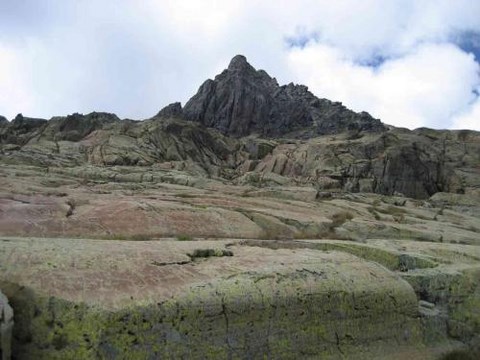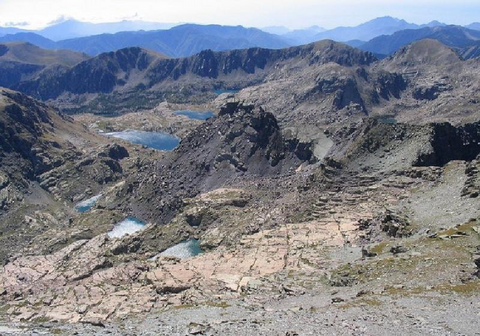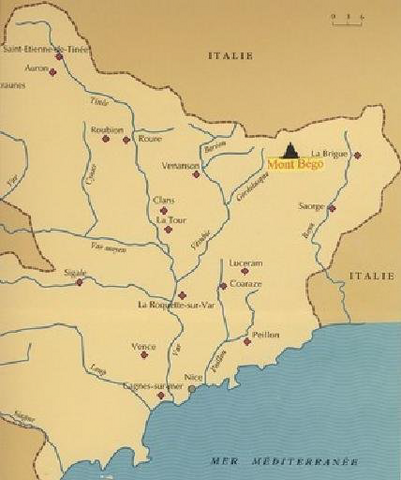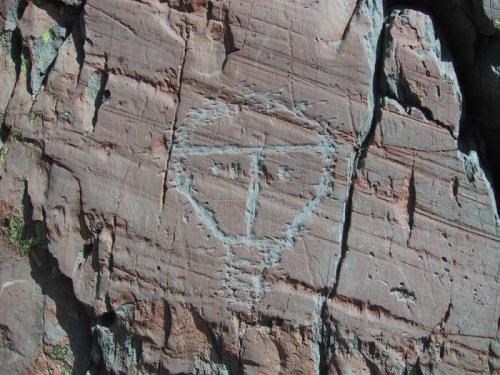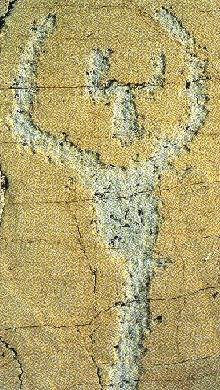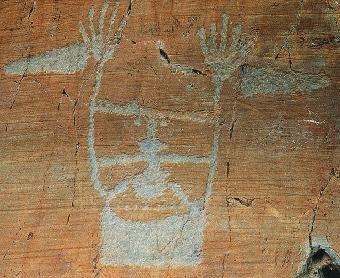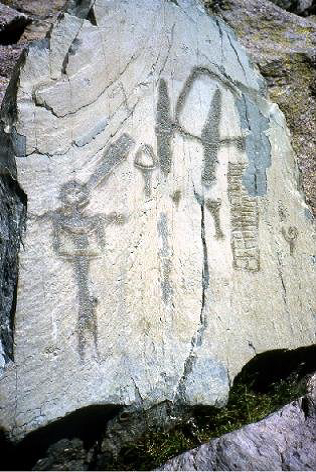The Petroglyphs of Mount Bégo
The Valley of Marvels
This entry is dedicated to Tony Peratt and to his ground-breaking work on petroglyphs.
Together with Valcamonica near Bergamo, in Italy, Mount Bégo and the Vallée des Merveilles, the Valley of Marvels, in Southern France, present the greatest concentration of petroglyphs in Europe.
Mount Bégo and the Valley of Marvels are located in the National Park of Mercantour, in the Alpes Maritimes, above the French Riviera, near the border with Italy, some 80 km north of Nice – one of the rare areas of the world which seems to have been inhabited by humans uninterruptedly, for the past several hundred thousand years. The site is snow-covered for eight months a year, and accessible only by foot, over difficult terrain, which explains why it has been so well preserved
.
Imposing Mount Bégo, height 2 872 meters, dominates the adjacent valleys, among them the Valley of the Marvels, where most of the most ancient petroglyphs are located. The "marvels" in question are the tremendous thunderstorms for which the Bégo area is known even today (from the early French meaning of merveille - "something beyond natural"). The relief has been heavily worked over by glaciers covering its slopes some 10,000 years ago.
Dragged off by glaciers, almost laminated by the movements of rocks and ice, there can be found moraines, glacially polished surfaces, and a few isolated rocks. On these polished slabs made of shist pelites and sandstone are found the great majority of the petroglyphs: the plane and colored surfaces show the engraved glyphs well.
Being difficult of access, the petroglyphs were not studied for a long time. But the existence of the petroglyphs was known and the place considered demonic. Througout the Middle Ages, it would remain known as a cursed place, a periphery of hell. And as such it attracted magi, astrologers and disciples of the Cathares and Vaudois (Waldensians), who were burned en masse in the main square of the neighboring town of Sospel. They, too, left behind their petroglyphs.

Pierre de Montfort reports in his travelogue in 1460:
"C’estait lieu infernal avecques
figures de diable et mille démones
partout taillez en rochiers…Peu s’en
fault qu’asme ne me faille ! "
"It was an infernal place with
figures of the devil and thousand demons
everywhere cut in the rocks… But for a little,
my soul would have failed me!"
Beginning in the 16th century, the Valley of Marvels gets mentioned in several written works , most of the time by authors who never where there : they carry on informations gathered from the inhabitants of the area. Curate Onorato Lorenzo, Abbot Pietro Gioffredo are among these writers who never set foot on Mount Bégo.
In 1801, François-Emmanuel Fodéré, a medical doctor, investigates part of the valley. He tells of his discoveries in a book published in 1821. He is one of the first one to describe in details what he saw.
In 1868, an English botanist, M.F.G.S. Moggridge is the first to attribute the petroglyphs to the prehistoric period. He is followed in 1877 by the prehistorian Emile Rivière who starts an in depth study of the site, with the help of a draftsman who makes detailed notes of the petroglyphs. His 1878 publication will allow the scientific community to take the measure of the importance of the rock engravings of Mount Bégo.
Among the scientists who studied the petroglyphs of the Valley of Marvels, three names should be cited :
Clarence Bicknell, a former pastor and botanist, who had first come to study the alpine flora of the area, in 1885. He settled in Val Casterino to pursue his botanic studies but also for the sake of studying the petroglyphs… He keeps discovering new engravings and surveys over 7,000 of them, before his death in 1918.
In 1927, a sculptor, Carlo Conti, picks up the torch. He surveys over 35 000 petroglyphs and establishes the first archaeological map of the site, numbering the glyphs. His studies end in 1942.
From 1967 to the present, Henry de Lumley organizes a systematic plotting of all the petroglyphs, together with the Institute of Human Paleontology in Paris, the Prehistory Laboratory of the Lazaret in Nice and the Musée des Merveilles de Tende, all services of the Counsel General of Alpes-Maritimes. There are research campaigns every summer.
Five categories of carvings have been distinguished : corniforms, weapons and tools, anthropomorphic figures, geometric figures and finally non-representative figures. Some representations are very frequents, such as the corniforms, the daggers… others are unique, such as the carving of the so-called « Sorcerer. »
The corniforms
The corniforms represent bulls, oxen or cows.
They are made up of a geometrical shape (a square, a tringle, a rectangle, a mere thick line…) from which emerge tw horns, more or less well worked over. Very rarely, some additional appendixes may evoke a tail, legs or the head of the animal.
Corniform figures represent 46% of the toal of the petroglyphs and even 79% if one takes into consideration only the “representative” carvings.
Of the 13 399 corniforms, 1167 are yoked, 12 232 are not.
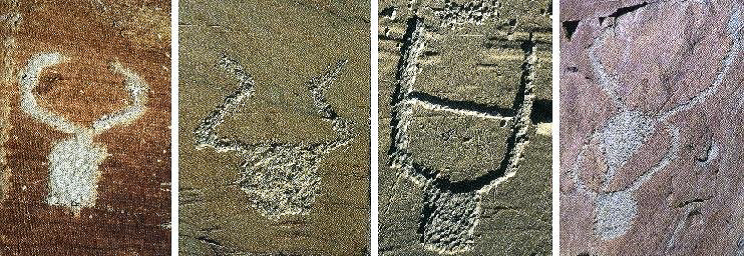
Geometric shapes
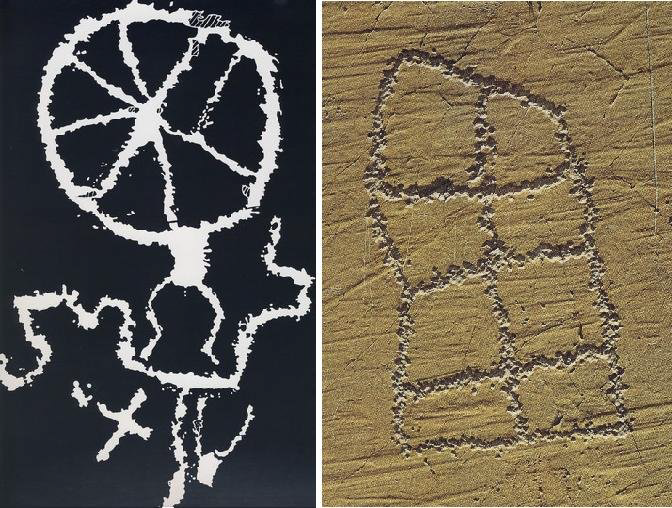
Three main types can be distinguished in this category : simple « rayed » figures (suns, crosses…), closed figures (circles, rectangles), and the reticulated (checkered) figures. The latter, the most numerous, may represent parcellated fields, sometimes crossed by a path or a stream of water... Geometric figures make up 7% of all carvings and 12,5% if one takes only into account representative ones.
Tools and Weapons
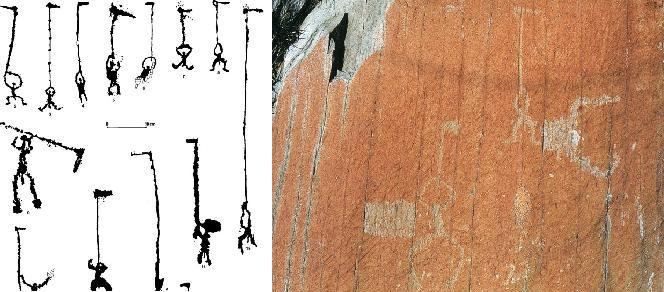
Weapons and tools are constituted mainly of hallebards and daggers. The latter, in largest number, can be recognized by the triangular shape of the blade and their generally shorter handle. Hallebards are made of a blade perpendicularly fixed on a long handle.
It was these weapons, particularly the daggers, which have served to date the carvings, by comparing them with weapons actually found.
Figures of weapons and tools represent 4% of the toal carvings, and 7,2% if one takes only into account the representative carvings.
Anthropomorphic shapes
Anthropomorphic figures are, as in all prehistoric art, the rarest of representations… On Mount Bégo, the little men are almost always displayed “in activity,” with arms raised, holding or dragging an object or a weapon. They are very schematic and stylized, with two legs, two arms, a head (without details) and sometimes a penis.
The anthropomorphic figures reresent only 0.2% of all carvings, 0.5 % of the « representative » ones.
But there are some anthropomorphic carvings which are quite different, even exceptional, such as the figure known as "Christ..."
Non-representative figures
They are exectuted like the other ones, by direct percussion on the rock. They are cup-shaped marks, aligned, isolated or in groups, aligned or simply grouped. One cannot make out a specific signification. They may simply be unfinished motives, "tests", figures started and « failed. » They represent 42,8% of the total carvings.
When and How were the carvings executed?
With present tecniques, it is not possible to arrive at an absolute dating of the petroglyphs of the Valley of Marvels. In order to find out the period in which the rock has been carved, scientists have used a method of relative dating. Studying represented objects, especially the weapons, they were able to determine that this type of dagger was used in the Chalcolithic (Age of Copper) and the early Bronze Age. On other sites of the Mediterranean Basin, identical daggers have been the object of precise datings, through direct and absolute methods.
We can therefore estimate that men have carved the rocks on Mount Bégo over a period included between 3200 and 1700 B.C., that is, over 4,000 years ago.
"At first glance, there’s a bundle of clues suggesting that the totality of the petroglyphs on Mount Bégo have been carved during a relativeley short protohistoric period in a sustained rhyhtm, » says Jérôme Magail (Musée d'Anthropologie Préhistorique de Monaco).
Quite logically, the artists preferred to use the flattest and smoothest surfaces. For some figures, scientists have been able to make out a “first draft” probably made with the tip of a stone.
The carvings were made by removing matter on a very small surface. Through little percussions with a stone tool (quartz) the carver dug small holes called micro-cupules. In multiplying the blows, he removed the superficial part of the rock to a depth of 0.5 to 5 mm. Microscope analysis of these “cupules” made it possible to determine the method that was used.
from: Hominides.com - la Vallée des Merveilles
Translated and adapted by Anne-Marie de Grazia


